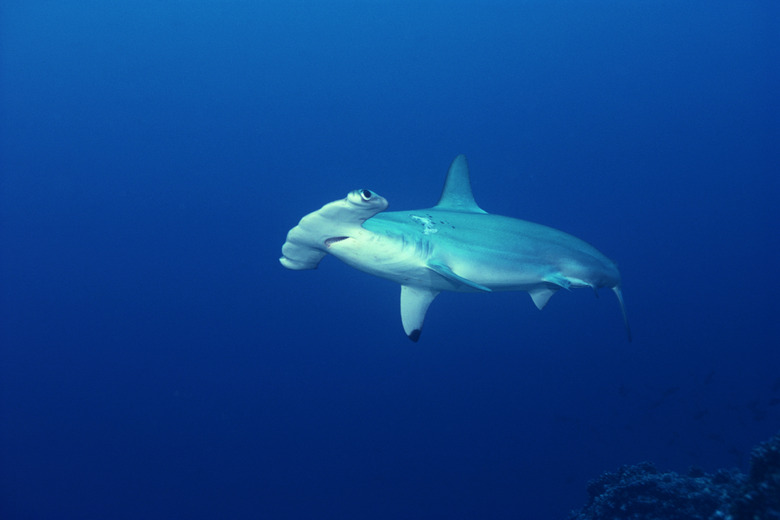What Is A Hammerhead Shark's Behavior Like?
Hammerhead sharks are one of the most recognizable sharks in the world, largely due to their hammer-shaped heads. These sharks' eyes are on the opposite sides of their heads, which allow them to have a wider vision than other sharks. Nine hammerhead shark species exist and hammerheads, which all belong to the Sphyrna genus, have similar behavioral characteristics.
Migration
Migration
During the summer, large schools of hammerheads migrate to find waters with cooler temperatures. Hammerheads also retreat back to warmer waters in the winter. Hammerheads live in marine water environments with tropical climates throughout the world, including the Indian Ocean, Atlantic Ocean, Pacific Ocean and Mediterranean Sea. These sharks are seen near shorelines and offshore. In U.S. waters, hammerheads usually live near the coastlines of Southern California, Texas, Louisiana, Mississippi, Florida, Georgia and the Carolinas.
Hunting
Hunting
Similar to other shark species, hammerheads are carnivorous, meaning they only eat meat. When hunting, hammerheads use sensory organs known as the ampullae of Lorenzini and lateral lines. The ampullae of Lorenzini sense electrical fields created by other animals, while lateral lines detect other animals' motions. One of the most common dietary items for hammerheads are stingrays; hammerheads will also eat a stingray's barbed tail. Fish, invertebrates and other sharks are also a part of a hammerhead's diet. Most hammerheads have small mouths that are suited to eating smaller animals; thus, hammerheads are rarely aggressive to humans. However, larger hammerhead species, such as the great hammerhead, sometimes attack humans.
Reproduction of the Hammerhead Shark
Reproduction of the Hammerhead Shark
For reproduction, hammerheads are oviparous, meaning they lay eggs rather than give live birth. These sharks mate in spring and summer. Males latch onto females with their intermittent organs, also known as claspers. The claspers release sperm into the female, which initiates the process of internal fertilization. Hammerheads have a gestation period of 11 months and approximately 30 to 40 young sharks, or pups, are born annually. Although most sharks mate near the bottom of the ocean, hammerheads gradually swim to the water's surface during the process.
Social Behavior
Hammerheads gather in large schools for hunting, migration and social purposes. For example, a school of scalloped hammerheads may have 100 to 500 specimens; however, the majority of hammerheads in a school are female. For communication, hammerheads use body language for establishing the social hierarchy and giving orders for the schools to disperse. Head shakes, torso thrusts and swimming in loops are some of the body language signals employed by hammerheads. Hammerheads are nocturnal, meaning they are most active during the evening.
Cite This Article
MLA
Davis, Skip. "What Is A Hammerhead Shark's Behavior Like?" sciencing.com, https://www.sciencing.com/hammerhead-sharks-behavior-like-10033087/. 7 August 2018.
APA
Davis, Skip. (2018, August 7). What Is A Hammerhead Shark's Behavior Like?. sciencing.com. Retrieved from https://www.sciencing.com/hammerhead-sharks-behavior-like-10033087/
Chicago
Davis, Skip. What Is A Hammerhead Shark's Behavior Like? last modified March 24, 2022. https://www.sciencing.com/hammerhead-sharks-behavior-like-10033087/
